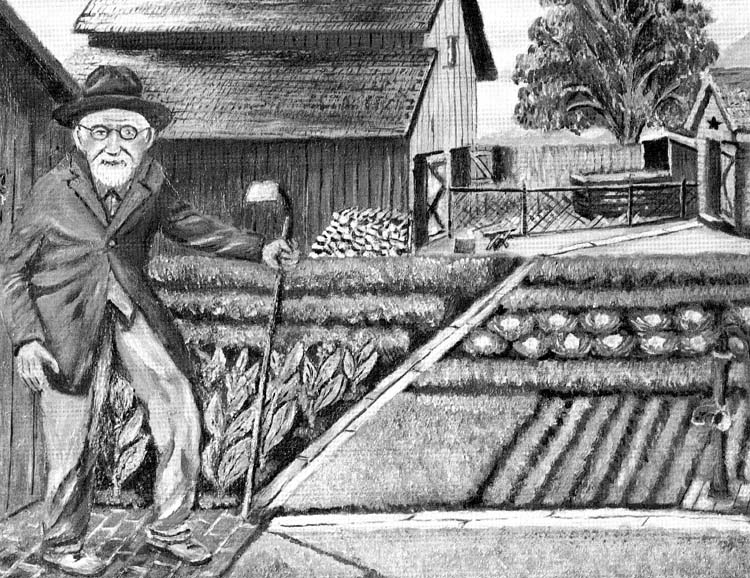
This oil depicts an Iowa City Goosetown neighborhood garden which includes tobacco behind
John Chopek’s legs, with a barn, pig run and outhouse all connected by board walks.
Image
courtesy Marybeth Slonneger from her 1999 Goosetown history, “Small But
Ours.”
|
By
Bob Hibbs
Tobacco
was grown in the vegetable gardens of Iowa City’s Goosetown neighborhood,
and fresh locally-brewed beer was as near as the corner grocery, thus
satisfying two principal male vices of a century ago.
In
fact, local tobacco growing was “quite prevalent during the late Victorian
period up until about World War I” (1880-1915), reports local historian
Marybeth Slonneger whose 1999 Goosetown history “Small But Ours” is
available in local bookstores.
It’s
a treasure trove of local images and vignettes. The accompanying image of an
oil painting by Leo Chopek of his grandfather in his Goosetown yard is from
the book, used here with Slonneger’s permission.
Goosetown
native and retiree Bob Kacena recalls that as a Press-Citizen carrier during
the early 1940s he’d stop in an East Church Street home to watch “old
bachelor” John Konvalinka roll cigars for sale locally.
The
1943 City Directory lists Konvalinka as a cigar manufacturer.
Racine’s
is one store – actually three separate locations downtown – always
mentioned as selling locally-made cigars. Another was Dunkel’s, and many
drug stores handled tobacco products from time to time.
“He’d
roll ‘em, press ‘em, apply a wrapper and pack ‘em 25 to a box,” Kacena
recalls. When asked if he ever smoked one, Kacena just grins sheepishly;
“don’t like cigars, never did,” he retorts. He is a 1950 City High grad.
The
cigar trimmings all were saved, he explained – and sold as chewing tobacco!
Retired
Iowa City schools instrumental music teacher and cigar aficionado Bob Moninger
says conditions aren’t right locally to grow good tobacco. Soil makeup, sun
and moisture at the right stages of growth are essential. In the end, Moninger
explains, it’s the taste and aroma of the tobacco that sell.
Locally-grown
tobacco was for home use, principally in pipes, while cigars made locally for
sale were from tobacco shipping in from growing areas in the southeast.
Christopher
Columbus discovered the stuff when he landed in Cuba in 1492; but, he got it
wrong. The natives referred to the pipe used in smoking as tobacco, while the
stuff that burned up was cohiba.
Cuban
president Fidel Castro resurrected the word during the late 1960s when he
began boxing the finest of his local cigars for foreign visitors under the
brand name “Cohiba,” perhaps Castro’s only commercial success during his
half-century of rule.
A
century ago, three breweries were operated within a block of each other along
Market Street from Linn to Gilbert. One structure – now called Brewery
Square – survives. The Englert operation was a half-block east along the
south side of Market where a parking lot now exists.
The
Dostal brewery was at Market and Gilbert where a paint store now exists.
The
most memorable local brew was Erlanger Beer, simply because it advertised
itself as “The Beer That Made Milwaukee Jealous.”
Fresh
brew made its way daily to pubs and corner groceries, from which it typically
was carried home in metal pots with covers. It was rarely chilled since
winter ice stored for summer cooling of milk and butter was too valuable to
use on beer.
In
her book, Slonneger reports that Joseph Shalla made cigars in Goosetown for
Racine’s cigar store, and Charles Bobrich saloon. She continues:
“Joe
was called ‘a man who never smiled,’ a trait which must have served him
well in his duel career as a professional gambler. He rented a few rooms on
the second floor of a downtown building for his cigar business, but also for
an ongoing poker game.
“It
was there that he won the homes of six or seven players that made him
unpopular with some of his peers, necessitating the hiring of his nephew Joe
Pec for protection,” Slonneger writes.
Oh,
so there must have been male vices besides tobacco and beer.
Next
Saturday: The Pentacrest update of
1905. Bob Hibbs collects local postcards and other historic ephemera and researches history related to them. |